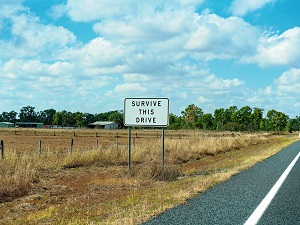Driver fatigue, which may be the result of insufficient sleep, long distances traveled, or long work shifts, is a major contributor to tragic motor vehicle collisions on and off the job.

Drowsy driving is dangerous even if the driver doesn’t actually fall asleep at the wheel. Lack of sleep can make drivers less alert and affect their coordination, judgement, and reaction time. Driver fatigue can result in cognitive impairment that is similar to distracted driving or even drunk driving.
The effects of driver fatigue, all of which may cause a crash, can include:
- Nodding off while driving
- Slower reaction time
- Poor decision making or unnecessary risk-taking
- Drifting out of the lane
- Tunnel vision (losing sense of what’s going on in the periphery)
- Microsleeps (dozing off for a few seconds)
- Low awareness (driving without noticing or remembering)
All drivers should have a good understanding of the dangerous consequences of fatigue while behind the wheel, as well as some knowledge about the causes of fatigue, who may be at a higher risk, warning signs of drowsy driving, and safety tips to try both before and during a long drive that can help prevent driver fatigue.

The causes of driver fatigue may be different for everyone, but some include:
- Being awake for too long
- Not getting enough sleep, or enough quality sleep, multiple days in a row
- The time of day depending on individual sleep/wake cycles
- Boring tasks or long periods of inactivity
- Health factors, including sleep disorders
- Medications, or alcohol, that may cause drowsiness
Those who are at an increased risk of driving while fatigued include drivers who do not get enough quality sleep, commercial drivers who operate tow trucks, tractor trailers, and buses, as well as shift workers on the night shift or who have irregular or long shifts. Also at an increase risk of driving while fatigued includes anyone with an untreated sleep disorder, drivers who use medications that may cause drowsiness, and teenagers who have less driving experience and higher rates of insufficient sleep.

Warning signs of drowsy driving include:
- Frequent yawning or blinking
- Feelings of dozing off
- Heavy sensation in the eyes
- Difficulty focusing
- Difficulty remembering the last few miles
- Missing a road sign or exit
- Following other vehicles too closely
- Difficulty maintaining proper speed
- Drifting from the lane
- Hitting a rumble strip
If you feel fatigued while driving it may help to pull over (safely), stretch, drink a cup of coffee (or caffeinated beverage), or even take a short nap before continuing.
The effects of ‘taking a break to wake up’ are only temporary as the only cure for fatigue is sleep. At a certain point there is no amount of determination, will power, motivation, or experience, that will overcome the body’s biological need for sleep.

There are plenty of safety tips to avoid drowsy driving before hitting the road.
Plan ahead to limit the number of driving hours each day. Break up a long drive into smaller segments and budget time for rest stops. Avoid driving when your body is usually sleeping, or you typically have a dip in energy. For most people this will be between midnight and 6am, and in the early afternoon.
Get plenty of restful sleep. Ideally, for multiple nights in a row before the drive. Don’t eat a large, heavy meal before driving. Avoid alcohol and sedatives. And, if possible, bring a travel companion.
If you begin to feel fatigued while driving ensure you plan rest stops and take frequent breaks. A recommendation is to take a break at least every 2 hours, or every 100 miles. Stay hydrated during the drive and bring healthy snacks. Listen to something interesting like a favorite podcast or audiobook.

To prevent drowsy driving, those who drive frequently should focus on their sleep quality. Plan off-duty activities to allow enough time for adequate sleep. Get enough sleep (7-9 hours per day). If needed, create a better sleeping environment in a dark, quiet, cool room with no electronics. If fatigue persists after adequate sleep, get screened for health problems that may be affecting the quality of sleep.
During an investigation after a driving-related incident, there may be questions related to sleep history, hours worked leading up to the incident, time of day, and hours spent driving to help determine if fatigue was a possible contributing factor. Answer fatigue-related questions honestly. Fatigue is a normal biological response which may indicate changes that need to occur to provide for a safer workplace.
Reduce the need for driving long distances if at all possible. Not all drivers will be able to do this, but if there is any flexibility offered, it may be helpful to consider handling some meetings by phone or video calls instead of driving to meet in-person. You may decide to choose alternate transportation like air, rail, public transport, or ride-sharing. Alternatively, you can combine trips and loads to reduce the number of drives.

.jpeg)

.jpeg)
.jpeg)
.jpg)